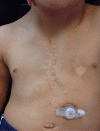Successful management of absent sternum in an infant using porcine acellular dermal matrix
- PMID: 30967520
- PMCID: PMC6759450
- DOI: 10.5999/aps.2018.00829
Successful management of absent sternum in an infant using porcine acellular dermal matrix
Abstract
Congenital absent sternum is a rare birth defect that requires early intervention for optimal long-term outcomes. Descriptions of the repair of absent sternum are limited to case reports, and no preferred method for management has been described. Herein, we describe the use of porcine acellular dermal matrix to reconstruct the sternum of an infant with sternal infection following attempted repair using synthetic mesh. The patient was a full-term male with trisomy 21, agenesis of corpus callosum, ventricular septal defect, patent ductus arteriosus, right-sided aortic arch, and congenital absence of sternum with no sternal bars. Following removal of the infected synthetic mesh, negative pressure wound therapy with instillation was used to manage the open wound and provide direct antibiotic therapy. When blood Creactive protein levels declined to ≤2 mg/L, the sternum was reconstructed using porcine acellular dermal matrix. At 21 months postoperative, the patient demonstrated no respiratory issues. Physical examination and computed tomography imaging identified good approximation of the clavicular heads and sternal cleft and forward curvature of the ribs. This case illustrates the benefits of negative pressure wound therapy and acellular dermal matrix for the reconstruction of absent sternum in the context of infected sternal surgical site previously repaired with synthetic mesh.
Keywords: Acellular dermis; Negative pressure wound therapy; Sternum; Surgical mesh; Thoracic surgery.
Conflict of interest statement
No potential conflict of interest relevant to this article was reported.
Figures



Similar articles
-
Reoperation 7 years after sternal reconstruction with a porcine acellular dermal matrix.Eur J Cardiothorac Surg. 2018 Sep 1;54(3):601-603. doi: 10.1093/ejcts/ezy055. Eur J Cardiothorac Surg. 2018. PMID: 29490047
-
Sternal cleft reconstruction with acellular dermal matrix and full-thickness calvarial graft.Eur J Cardiothorac Surg. 2023 Apr 3;63(4):ezad126. doi: 10.1093/ejcts/ezad126. Eur J Cardiothorac Surg. 2023. PMID: 37010514
-
Congenital sternal cleft with patent ductus arteriosus: report of a case.Surg Today. 2002;32(1):66-8. doi: 10.1007/s595-002-8116-1. Surg Today. 2002. PMID: 11871821 Review.
-
Porcine Acellular Dermal Matrix for Hernia Repair in Transplant Patients.Ann Plast Surg. 2016 Dec;77(6):674-677. doi: 10.1097/SAP.0000000000000929. Ann Plast Surg. 2016. PMID: 27759588
-
Cleft sternum and sternal foramen.Chest Surg Clin N Am. 2000 May;10(2):261-76. Chest Surg Clin N Am. 2000. PMID: 10803333 Review.
Cited by
-
Congenital Absence of Sternum: A Surgical Technique for Successful Outcome.Cureus. 2024 Feb 19;16(2):e54488. doi: 10.7759/cureus.54488. eCollection 2024 Feb. Cureus. 2024. PMID: 38516421 Free PMC article.
-
Outcomes of primary repair of sternal cleft defects: Providing a "bony cover".Ann Pediatr Cardiol. 2022 May-Jun;15(3):244-248. doi: 10.4103/apc.apc_190_21. Epub 2022 Nov 16. Ann Pediatr Cardiol. 2022. PMID: 36589643 Free PMC article.
References
-
- Suri RK, Sharma RK, Jha NK, et al. Complete congenital sternal cleft in an adult: repair by autogenous tissues. Ann Thorac Surg. 1996;62:573–5. - PubMed
-
- Kohli V, Nooreyazdan S, Das BN, et al. Surgical reconstruction for absence of sternum and pericardium in a newborn. Indian J Pediatr. 2006;73:367–8. - PubMed
-
- Al-Yamani M, Lavrand F, Thambo JB, et al. Upper sternal cleft with a complex congenital heart defect: repair in a single stage. Ann Thorac Surg. 2016;101:760–2. - PubMed
LinkOut - more resources
Full Text Sources

